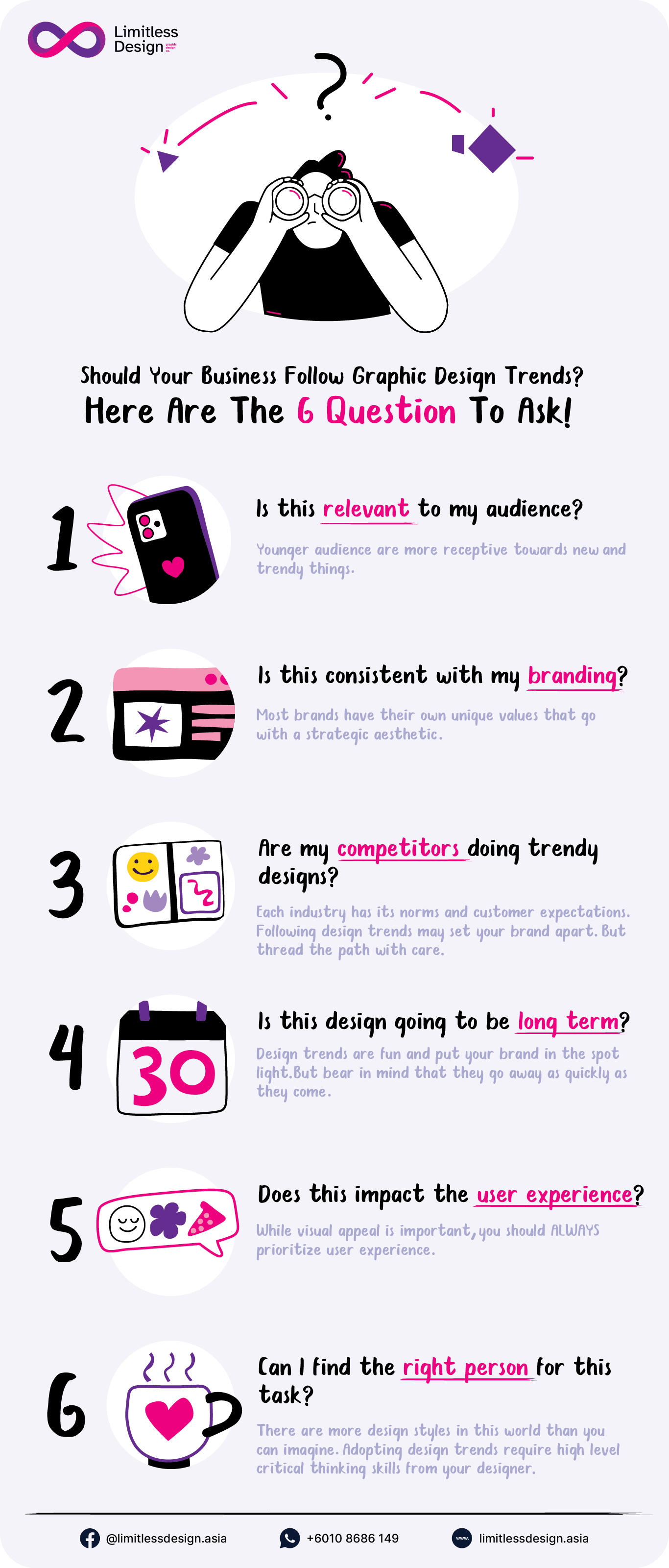Graphic design is an essential part of any business strategy, from branding to marketing and advertising. As businesses evolve and adapt to new technologies and market trends, graphic design trends also evolve to reflect these changes. In this article, we’ll explore whether or not your business should follow graphic design trends.
Why Graphic Design Is Important For Businesses
1. A Unique Brand Identity
Graphic design is essential for businesses for several reasons. Firstly, it is a powerful tool for creating a brand identity that stands out from the competition. A well-designed logo and visual identity can make a significant impact on how a company is perceived by its target audience. It can help to establish brand recognition and differentiate a business from its competitors.
2. Effective Marketing And Advertising
Secondly, graphic design is crucial for marketing and advertising efforts. Effective marketing materials, such as brochures, flyers, and advertisements, require a strong visual design that communicates the message clearly and attracts attention. Graphic design can help to create marketing materials that are both visually appealing and effective in communicating the desired message.
3. Positive User Experience
Thirdly, graphic design is essential for creating a positive user experience. Websites, apps, and other digital platforms require an intuitive and visually appealing design to ensure a positive user experience. A well-designed user interface can improve the usability of a platform and enhance user engagement, leading to increased customer satisfaction and loyalty.
How Businesses Shape Graphic Design Trends
1. Evolving Technology
Businesses play a significant role in shaping graphic design trends. As businesses evolve and adapt to new technologies and market trends, graphic design trends also evolve to reflect these changes. For example, the rise of AI has led to a shift towards realistic artwork as graphic designers implement AI in their workflow.
2. Successes of Global Brands
Another way businesses shape graphic design trends is through their branding and marketing efforts. The design choices made by a business can influence the broader design landscape, as other companies seek to emulate successful design strategies. For example, the success of Apple’s minimalist design has led to a trend in flat design, with other companies adopting similar design principles.
3. Creative Collaborations
Businesses can also shape graphic design trends by working closely with designers and providing feedback on their designs. This collaboration can lead to new design trends and innovations as businesses seek to create unique and effective designs that stand out in a crowded market.
Should Your Business Adopt Graphic Design Trends?
Whether businesses should adopt graphic design trends depends on several factors, including your target audience, brand identity, industry, and overall marketing strategy. Here are some considerations to keep in mind:
1. Relevance To Your Target Audience
Graphic design trends often emerge as a response to evolving consumer preferences. If the target audience is receptive to and influenced by current design trends, adopting them can help businesses stay visually appealing and engaging.
2. Brand Consistency
While incorporating design trends can freshen up a brand’s visual identity, it’s crucial to maintain consistency with the established brand image. Consistency in design elements, such as logos, colour schemes, and typography, helps build brand recognition and trust. Evaluate how well a trend aligns with your brand’s values, personality, and overall aesthetic.
3. Industry And Competition
Consider the norms and expectations within your industry. If your competitors are embracing certain design trends, it may be worthwhile to assess their impact on consumer perception and competitiveness. However, blindly following trends without considering their relevance may result in a lack of differentiation.
4. Longevity
Design trends can be transient, with some becoming outdated quickly. Consider whether a trend is likely to have a lasting impact or if it is just a passing fad. Investing in design elements that have long-term relevance can save costs on frequent redesigns.
5. User Experience
While visual appeal is important, it should not overshadow the user experience. Ensure that any design changes align with usability principles, making it easy for users to navigate and interact with your products or services.
6. Professional Expertise
Graphic design is a specialized field, and adopting trends requires the skills and expertise of experienced designers. It’s important to have a design team or hire professionals who understand the trends and can implement them effectively.
Ultimately, businesses should strike a balance between incorporating relevant design trends and maintaining a consistent brand identity. Regularly assessing and adapting to the changing design landscape can help businesses stay visually appealing and relevant to their target audience.

Think Twice and Consult Designers
As businesses evolve and adapt to new technologies and market trends, they also shape the graphic design landscape, influencing design trends through their branding, marketing, and collaboration with designers. By working closely with designers and staying attuned to the latest design trends, you can create effective and impactful designs that resonate with you target audience and drive success in your respective industries.

